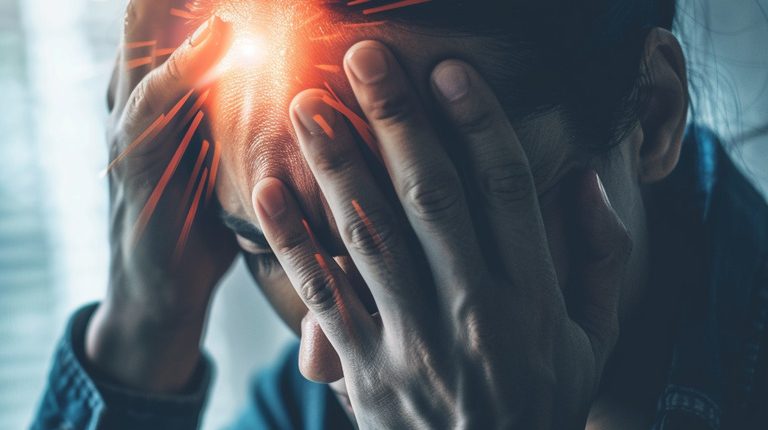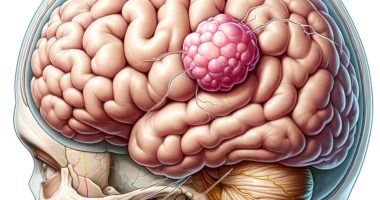Meningitis
What is meningitis?
A pathological condition characterized by inflammation of the brain and spinal cord membranes is called meningitis. Diagnosis and treatment of this disease is carried out by neurologists.
Meningitis may manifest by soft, arachnoid, or dura mater inflammation. In clinical practice, it is more often diagnosed as a lesion of the soft cerebral membranes. This is a dangerous disease, the main symptoms of which doctors include severe headache, increased body temperature, and increased tone of the occipital muscles. Young children may have nonspecific symptoms, such as irritability, drowsiness, and poor appetite. The inflammatory process itself in the membranes of the brain and spinal cord is caused by viruses, bacteria, fungi, or protozoan unicellular microorganisms.
Due to the proximity of inflammation to brain tissue, meningitis can be fatal, so it is necessary to seek medical help when the first signs of the disease appear. Each year, this pathology is diagnosed in about 9 million people worldwide. Antimicrobial drugs are usually used as a first-line treatment. Without timely medical attention, the pathology may be complicated by cerebral hydrocele, deafness, impaired mental development in the child, or more severe conditions.
Symptoms of meningitis
Signs of the disease depend on the patient’s age, the infectious agent’s characteristics, and the inflammatory process’s severity. Characteristic symptoms of meningitis can be divided into nonspecific manifestations of infection, such as increased body temperature and signs of central nervous system damage, which include muscle tension, painful reaction to light, and other unpleasant sensations. Children and the elderly are more likely to have subtle manifestations of the disease: low mood, drowsiness, and hand tremors.
Other symptoms:
- Excruciating headache spreading to the neck area;
- Nausea and vomiting not due to food intake;
- Involuntary muscle contractions (seizures) in children;
- Heart palpitations;
- Pupil dilation;
- Confusion and impaired spatial coordination;
- Daytime sleepiness;
- Lack of appetite and thirst;
- Painful reaction to noise and pungent odors;
- Skin rash.
If you have such symptoms, we advise you to make an appointment with a doctor. Timely consultation will preventnegative consequences for your health.
Because young children may not show obvious signs of meningitis, paying attention to the child’s behavior is essential. Excessive sleepiness, refusal to eat, and prolonged sitting in one position may indicate an infection of the brain membranes. Infants sometimes show specific signs of the disease, such as severe swelling of the fontanel.
Causes of meningitis
Viruses and bacteria most often cause inflammation of the brain membranes. These can be streptococci, Neisseria, Coxsackie enteroviruses, or other pathogens. In most cases, meningitis becomes a complication of a chronic or acute infection already occurring in the body. Microorganisms can migrate into the brain membranes from other anatomical regions through blood or lymphatic vessels. It is also possible for pathogens to enter the central nervous system through the placenta or by contact with cerebrospinal fluid.
Possible causes and risk factors:
- Open head injury or spinal cord injury with the spinal cord;
- Acute and chronic infections of the lungs, bronchi, and upper respiratory system;
- Infectious diseases of the teeth and surrounding tissues;
- Violation of the integrity of the bones of the skull with the release of cerebrospinal fluid;
- Infection of the maxillary sinuses (maxillary sinusitis);
- Undergone surgery on the brain or spinal cord;
- Decreased activity of the immune system against the background of HIV infection, alcoholism, diabetes mellitus, or other pathological conditions;
- Lack of meningococcal vaccination in the presence of meningitis risk factors, including working with sick people, decreased immunity, and living in a dormitory.
Some meningitis pathogens cause well-recognized symptoms. For example, skin rashes are common in meningococcal infections.
Diagnosis of meningitis
Early diagnosis of meningitis is based on detecting characteristic clinical signs of the disease and laboratory tests. The neurologist will examine a patient to identify complaints and carefully study anamnestic data to search for risk factors for the disease. A general examination is also performed to detect tension of the occipital muscles, skin rashes, cranial soreness, and other clinical signs. After the initial examination, the neurologist conducts laboratory and instrumental diagnostics to confirm the disease and determine the type of infectious agent.
Prescribed diagnostic tests in:
- Lumbar puncture. An experienced physician carefully inserts a needle into the area between the lumbar vertebrae, reaches the subcutaneous space, and extracts approximately 120 milliliters of fluid. It is a standard neurological practice procedure characterized by safety and reliability. The layer-by-layer administration of an anesthetic drug during the procedure avoids discomfort. After fluid intake, the neurologist asks the patient to lie on the stomach and maintain this position for 2 hours.
- Blood test. The doctor takes venous blood to determine the chemical composition and cellular indicators. It is an important method of assessing the patient’s condition. In addition, a bacterial culture can be obtained from the blood sample to determine the type of pathogen.
- Computed tomography or magnetic resonance imaging of the brain and spinal cord. These are simple and painless manipulations, the results of which have a high diagnostic value. The neurologist receives images of the affected organs, identifies signs of inflammation of the brain membranes, and excludes the presence of complications.
Treatment for meningitis
Bacterial meningitis: Requires immediate antibiotic and corticosteroid therapy to reduce complications.
Viral meningitis: Often mild; treatment focuses on relief of symptoms.
Fungal meningitis: Treated with antifungal medications.
Non-infectious meningitis: Treatment targets the underlying cause.
All these treatment options and procedures can be done in more than 560 hospitals worldwide (https://doctor.global/results/diseases/meningitis). For example, lumbar puncture can be performed in 22 clinics across Germany for an approximate price of $1,774 (https://doctor.global/results/europe/germany/all-cities/all-specializations/procedures/lumbar-puncture).
Meningitis prevention
If you follow the doctor’s recommendations, you can avoid the occurrence of such a dangerous disease.
Basic prevention methods:
- Providing vaccination against meningococcal infection;
- Timely elimination of chronic foci of infection;
- Regular water procedures and exercise;
- Avoiding contact with sick people when living in dormitories and mass gatherings.
When the characteristic symptoms of meningitis appear in the clinic, you can immediately undergo the necessary examinations.
Conclusion
Meningitis remains a significant public health concern due to its potential severity and rapid progression. Awareness of its symptoms, early diagnosis, and treatment, coupled with effective preventive strategies, are key to reducing its impact. With ongoing research and advancements in medical science, there is hope for more effective treatments and preventive measures against this challenging condition.



